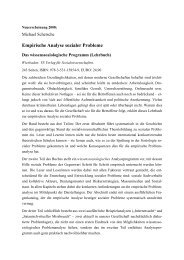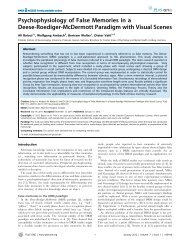2 Projects and Results - IGPP
2 Projects and Results - IGPP
2 Projects and Results - IGPP
Create successful ePaper yourself
Turn your PDF publications into a flip-book with our unique Google optimized e-Paper software.
2 Theory <strong>and</strong> Data Analysis<br />
on neural states. If neural states are described as effects of<br />
previous neural states, then an additional mental influence<br />
(mental causation) “overdetermines” the neural states. This<br />
can lead to severe inconsistencies which can be avoided if<br />
mental states are well-defined on the basis of proper partitions<br />
of the underlying neural state space. This entails a<br />
correlational balance of mental <strong>and</strong> neural states which, according<br />
to the interlevel relation of contextual emergence,<br />
respects both neural <strong>and</strong> mental features.<br />
Atmanspacher; together with Bishop, Harbecke<br />
Panexperientialism in Dual-Aspect Models<br />
Following up on a proposal by Primas, we studied the possibility<br />
to translate the mind-matter distinction into terms<br />
of mental <strong>and</strong> physical time. In the spirit of this idea,<br />
we hypothesized a relation between the intensity of mental<br />
presence <strong>and</strong> a time scale (some seconds) often referred<br />
to as a measure for the duration of nowness. This duration<br />
is experimentally accessible <strong>and</strong> might offer a suitable<br />
way to characterize the intensity of mental presence. Some<br />
features consistent with other, related ideas have been indicated<br />
<strong>and</strong> interesting consequences with respect to the<br />
idea of a generalized notion of mental presence, with human<br />
consciousness as a special case, have been outlined. In<br />
particular, the phenomenal experience of nowness can be<br />
regarded as a fundamental quale, thus providing a concrete<br />
option, to be explored in more detail, to address the idea of<br />
panexperientialism.<br />
Atmanspacher; together with Franck<br />
Publication: Franck, Atmanspacher (2008)<br />
Riemann’s Philosophical Speculations<br />
Posthumously edited fragments of the distinguished mathematician<br />
Bernhard Riemann (1826–1866) document his<br />
attempts to integrate physical <strong>and</strong> mental phenomena in a<br />
universal framework. For this purpose Riemann adopted<br />
a basic idea of the philosopher Herbart (1776–1841) who<br />
conceived of science as the “reworking of concepts”. One<br />
goal of this project was to outline Riemann’s sketchy <strong>and</strong><br />
often amazing speculations in their full breadth. Emphasis<br />
is put on the idea that Riemann may have sought the<br />
link between the material <strong>and</strong> the mental in the notion of<br />
an “agens”, wherein the concepts of state <strong>and</strong> change converge.<br />
The interaction between Riemann <strong>and</strong> Herbart can<br />
serve as a case in point for the impact of philosophy on the<br />
development of science in the 19th century.<br />
Ehm<br />
Journal “Mind <strong>and</strong> Matter”<br />
The journal “Mind <strong>and</strong> Matter” was established in 2003 <strong>and</strong><br />
has received increasing visibility as a medium for questions<br />
of mind-matter research since then. The journal appears<br />
semi-annually, <strong>and</strong> the contents of all issues published so<br />
far can be found at www.mindmatter.de. The number<br />
of submissions grows continuously, the current aceptance<br />
rate is about 35%. Since 2005 the journal has been produced<br />
<strong>and</strong> distributed by Imprint Academic, Exeter (UK);<br />
the editorial office has remained in the h<strong>and</strong>s of the <strong>IGPP</strong><br />
theory group. The themes of the 2008 <strong>and</strong> 2009 issues were<br />
“Psychophysics: Puzzles <strong>and</strong> Prospects”, “Consciousness<br />
Across Cultures”, Free Will: Foundational Frameworks”,<br />
<strong>and</strong> “Expounding Emotions”.<br />
Atmanspacher, Moos<br />
Publications: Atmanspacher, ed., Mind <strong>and</strong> Matter 6(1),<br />
6(2), 7(1), 7(2)<br />
2.1.2 Generalized Quantum Theory<br />
Quantum theory contains two key concepts, complementarity<br />
<strong>and</strong> entanglement, that are often metaphorically applied<br />
to situations beyond physics. In 2002 we proposed<br />
an axiomatically formalized, generalized quantum theory to<br />
make such applications more rigorous. The crucial formal<br />
criterion leading to complementarity <strong>and</strong> entanglement is<br />
the non-commutativity of particular observables of the system<br />
considered. The ordinary Hilbert space quantum mechanics<br />
can be recovered by stepwise adding the necessary<br />
features. This provides a hierarchy of formal frameworks<br />
of decreasing generality <strong>and</strong> increasing specificity.<br />
Recently we started to work out more refined accounts of<br />
the notion of observables versus operations, of the distinction<br />
between ontic <strong>and</strong> epistemic states, <strong>and</strong> the consequences<br />
of these distinctions for Bell-type inequalitities.<br />
An earlier survey paper on generalized quantum theory was<br />
translated into French, <strong>and</strong> two articles accessible for nonexperts<br />
have been published as well.<br />
Atmanspacher, Filk; together with Römer<br />
Publication: Atmanspacher, Filk, Römer (2009), Atmanspacher<br />
(2009d), Atmanspacher (in press)<br />
Non-Commutative Operations in Psychology<br />
Non-commutativity, hence complementarity, plays a significant<br />
role in many situations in psychology. In simple<br />
words this means that the result of successive operations A<br />
<strong>and</strong> B depends on their sequence. This is to be expected if<br />
measurement operations are conceived as interactions between<br />
measuring <strong>and</strong> measured system rather than mappings<br />
from measured to measuring system. Such interactive<br />
measurement operations can be formalized by multiplicative<br />
sets of operators which do not commute with each<br />
other, AB ≠ BA. Pertinent examples are: (i) processes<br />
involved in the perception of bistable stimuli, <strong>and</strong> (ii) processes<br />
involved in learning operations in (small) networks.<br />
An additional topic that we started to study refers to context<br />
effects in questionnaires, indicating that the sequence<br />
of questions may be crucial for the responses.<br />
Atmanspacher, Filk; together with Römer<br />
Complementarity of Mental Descriptions<br />
Descriptions of mental states <strong>and</strong> their dynamics are incompatible,<br />
or even complementary, if they are based on an improper<br />
partition of the underlying neural state space. Compatible<br />
descriptions at the psychological level, which are<br />
topologically equivalent, i.e. consistent, with the underlying<br />
neurobiological description, emerge only if the mental<br />
states defined at the psychological level are dynamically<br />
stable. If the neural dynamics is sufficiently complex,



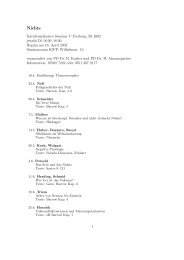
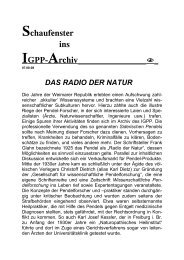
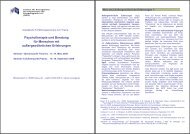
![Findliste Nachträge1 [pdf] - IGPP](https://img.yumpu.com/22552359/1/184x260/findliste-nachtrage1-pdf-igpp.jpg?quality=85)

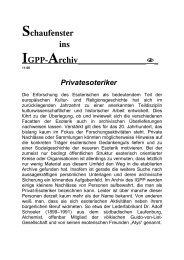
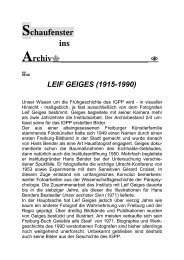
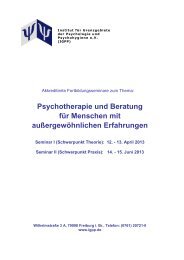
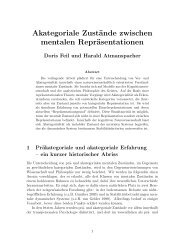
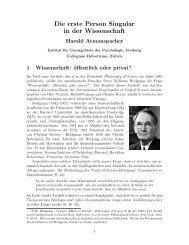
![Findliste [pdf] - IGPP](https://img.yumpu.com/22552265/1/190x245/findliste-pdf-igpp.jpg?quality=85)

